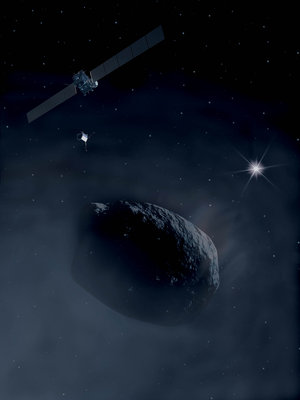Accept all cookies Accept only essential cookies See our Cookie Notice

About ESA
The European Space Agency (ESA) is Europe’s gateway to space. Its mission is to shape the development of Europe’s space capability and ensure that investment in space continues to deliver benefits to the citizens of Europe and the world.
Highlights
ESA - United space in Europe
This is ESA ESA facts Member States & Cooperating States Funding Director General Top management For Member State Delegations European vision European Space Policy ESA & EU Space Councils Responsibility & Sustainability Annual Report Calendar of meetings Corporate newsEstablishments & sites
ESA Headquarters ESA ESTEC ESA ESOC ESA ESRIN ESA EAC ESA ESAC Europe's Spaceport ESA ESEC ESA ECSAT Brussels Office Washington OfficeWorking with ESA
Business with ESA ESA Commercialisation Gateway Law at ESA Careers Cyber resilience at ESA IT at ESA Newsroom Partnerships Merchandising Licence Education Open Space Innovation Platform Integrity and Reporting Administrative Tribunal Health and SafetyMore about ESA
History ESA Historical Archives Exhibitions Publications Art & Culture ESA Merchandise Kids Diversity ESA Brand Centre ESA ChampionsLatest
Space in Member States
Find out more about space activities in our 23 Member States, and understand how ESA works together with their national agencies, institutions and organisations.
Science & Exploration
Exploring our Solar System and unlocking the secrets of the Universe
Go to topicAstronauts
Missions
Juice Euclid Webb Solar Orbiter BepiColombo Gaia ExoMars Cheops Exoplanet missions More missionsActivities
International Space Station Orion service module Gateway Concordia Caves & Pangaea BenefitsLatest
Space Safety
Protecting life and infrastructure on Earth and in orbit
Go to topicAsteroids
Asteroids and Planetary Defence Asteroid danger explained Flyeye telescope: asteroid detection Hera mission: asteroid deflection Near-Earth Object Coordination CentreSpace junk
About space debris Space debris by the numbers Space Environment Report In space refuelling, refurbishing and removingSafety from space
Clean Space ecodesign Zero Debris Technologies Space for Earth Supporting Sustainable DevelopmentLatest
Applications
Using space to benefit citizens and meet future challenges on Earth
Go to topicObserving the Earth
Observing the Earth Future EO Copernicus Meteorology Space for our climate Satellite missionsCommercialisation
ESA Commercialisation Gateway Open Space Innovation Platform Business Incubation ESA Space SolutionsLatest
Enabling & Support
Making space accessible and developing the technologies for the future
Go to topicBuilding missions
Space Engineering and Technology Test centre Laboratories Concurrent Design Facility Preparing for the future Shaping the Future Discovery and Preparation Advanced Concepts TeamSpace transportation
Space Transportation Ariane Vega Space Rider Future space transportation Boost! Europe's Spaceport Launches from Europe's Spaceport from 2012Latest

From launch to encounter
Thank you for liking
You have already liked this page, you can only like it once!
From launch to encounter
Rosetta's ten-year journey started on 2 March 2004, with an Ariane 5 launch from Europe’s Spaceport in French Guiana. Rosetta then circled the Sun and gained velocity from the gravitational ‘kicks’ provided by a complex series of close flybys of Earth and Mars. On its long journey Rosetta also entered the asteroid belt twice and passed close to asteroids Steins and Lutetia, obtaining unprecedented views and scientific data on these rocky objects.
Operating on solar energy alone, Rosetta was placed into deep space hibernation in June 2011 as it cruised out to a distance of nearly 800 million km from the warmth of the Sun, beyond the orbit of Jupiter.
Thirty-one months later, on 20 January 2014, Rosetta “woke up” from hibernation in order to prepare for its rendezvous with Comet 67P/Churyumov-Gerasimenko as they both head back into the inner Solar System. Between May and August a critical sequence of ten major manoeuvres were carried out to match Rosetta’s trajectory and velocity with that of the comet. Thus on 6 August 2014, the spacecraft rendezvoused with the comet at a distance of 100 km. Since then, the spacecraft has moved progressively closer to the comet, and is now preparing to deploy its lander Philae to the comet’s surface. Philae will be released on 12 November 2014, and once anchored to the surface it will send back high-resolution images and perform in situ analysis.
Rosetta will follow the comet throughout the remainder of 2015, including its closest passage to the Sun in August, to witness how it changes when subjected to increased solar radiation.
Image captions
Launch from Europe’s Spaceport 2004
First Earth flyby 2005
Mars flyby 2007
Second Earth flyby 2007
Flyby Asteroid Steins 2008
Third Earth flyby 2009
Flyby Asteroid Lutetia 2010
-
CREDIT
ESA -
LICENCE
ESA Standard Licence

Rosetta orbiting Comet 67P/Churyumov-Gerasimenko

Rosetta approaching its ultimate destination: Comet…

Rosetta: Europe’s comet chaser

Rosetta’s deep-space journey















 Germany
Germany
 Austria
Austria
 Belgium
Belgium
 Denmark
Denmark
 Spain
Spain
 Estonia
Estonia
 Finland
Finland
 France
France
 Greece
Greece
 Hungary
Hungary
 Ireland
Ireland
 Italy
Italy
 Luxembourg
Luxembourg
 Norway
Norway
 The Netherlands
The Netherlands
 Poland
Poland
 Portugal
Portugal
 Czechia
Czechia
 Romania
Romania
 United Kingdom
United Kingdom
 Slovenia
Slovenia
 Sweden
Sweden
 Switzerland
Switzerland

























